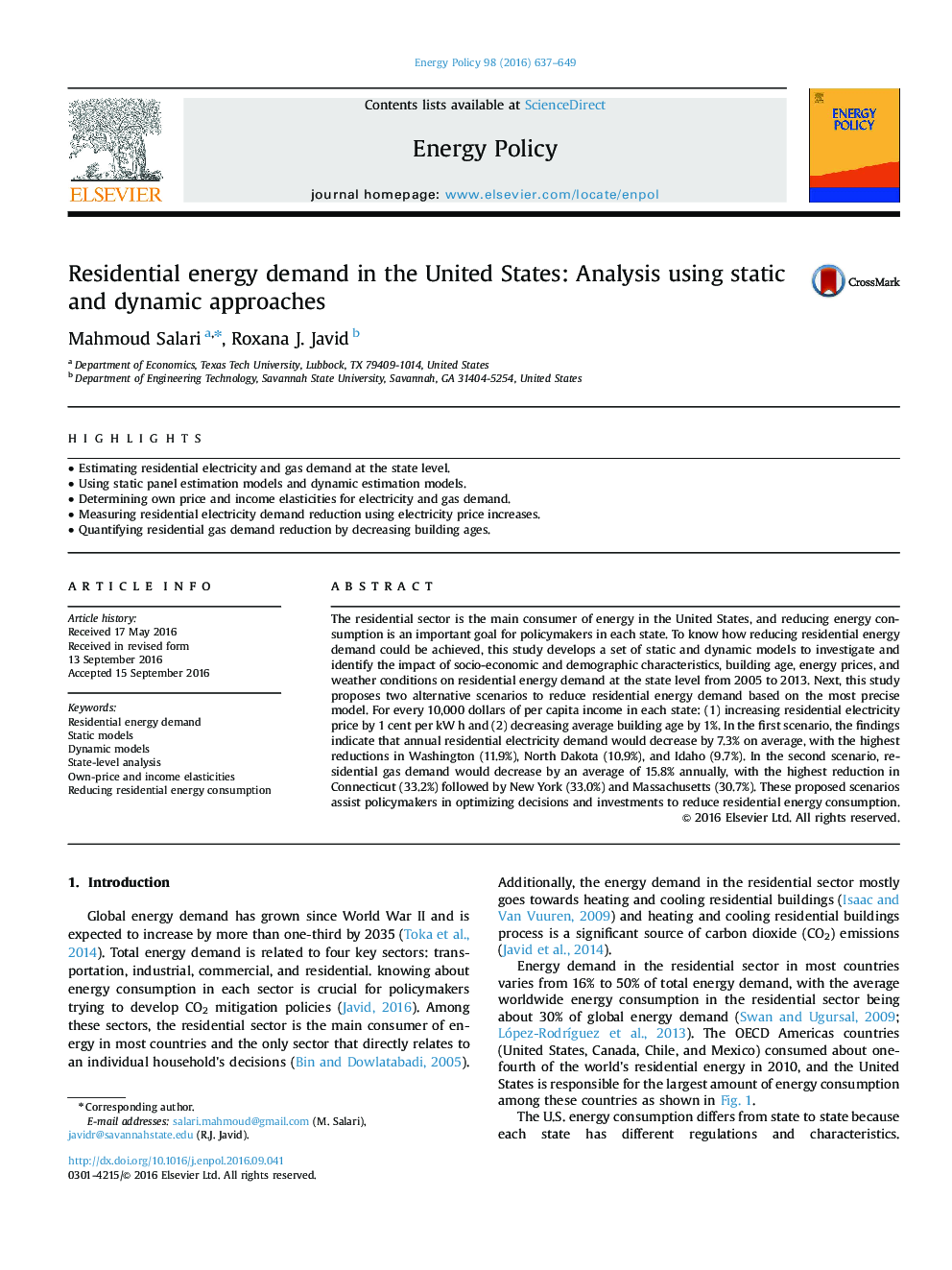| کد مقاله | کد نشریه | سال انتشار | مقاله انگلیسی | نسخه تمام متن |
|---|---|---|---|---|
| 7398443 | 1481260 | 2016 | 13 صفحه PDF | دانلود رایگان |
عنوان انگلیسی مقاله ISI
Residential energy demand in the United States: Analysis using static and dynamic approaches
ترجمه فارسی عنوان
تقاضای انرژی مسکونی در ایالات متحده: تجزیه و تحلیل با استفاده از روش های استاتیک و پویا
دانلود مقاله + سفارش ترجمه
دانلود مقاله ISI انگلیسی
رایگان برای ایرانیان
کلمات کلیدی
تقاضای انرژی مسکونی، مدلهای استاتیک، مدل های پویا، تجزیه و تحلیل سطح دولتی، قیمت گذاری و انعطاف پذیری درآمد، کاهش مصرف انرژی مسکونی،
ترجمه چکیده
بخش مسکونی مصرف کننده اصلی انرژی در ایالات متحده است و کاهش مصرف انرژی یک هدف مهم برای سیاست گذاران در هر ایالت است. به منظور شناخت چگونگی تقلیل تقاضای انرژی مسکونی، این مطالعه، مجموعه ای از مدل های ایستا و پویا را برای بررسی و شناسایی تاثیرات اجتماعی-اقتصادی و جمعیت شناختی، ساختن سن، قیمت انرژی و شرایط آب و هوایی در تقاضای انرژی مسکونی در سطح دولتی از سال 2005 تا 2013 است. در ادامه، این مطالعه دو سناریو جایگزین برای کاهش تقاضای انرژی مسکونی بر اساس دقیق ترین مدل ارائه می دهد. برای هر 10،000 دلار درآمد سرانه در هر ایالت: 1) افزایش قیمت برق مسکونی به میزان یک سنت در کیلو وات ساعت و 2) کاهش میانگین سن ساختمان در 1 درصد. در اولین سناریو، یافته های نشان می دهد که تقاضای برق خانگی سالانه به طور متوسط به میزان 7.3٪ کاهش می یابد، با بیشترین کاهش در واشنگتن (11.9٪)، داکوتای شمالی (10.9٪) و آیداهو (9.7٪). در سناریوی دوم، تقاضای تقاضای مسکونی به طور میانگین سالانه به میزان 15.8 درصد کاهش می یابد، با بیشترین کاهش در کانکتیکات (33.2 درصد) و نیویورک (33.0 درصد) و ماساچوست (30.7 درصد). این سناریوهای پیشنهادی به سیاستگذاران کمک می کنند تا بهینه سازی تصمیم ها و سرمایه گذاری برای کاهش مصرف انرژی مسکونی.
موضوعات مرتبط
مهندسی و علوم پایه
مهندسی انرژی
مهندسی انرژی و فناوری های برق
چکیده انگلیسی
The residential sector is the main consumer of energy in the United States, and reducing energy consumption is an important goal for policymakers in each state. To know how reducing residential energy demand could be achieved, this study develops a set of static and dynamic models to investigate and identify the impact of socio-economic and demographic characteristics, building age, energy prices, and weather conditions on residential energy demand at the state level from 2005 to 2013. Next, this study proposes two alternative scenarios to reduce residential energy demand based on the most precise model. For every 10,000 dollars of per capita income in each state: (1) increasing residential electricity price by 1 cent per kWÂ h and (2) decreasing average building age by 1%. In the first scenario, the findings indicate that annual residential electricity demand would decrease by 7.3% on average, with the highest reductions in Washington (11.9%), North Dakota (10.9%), and Idaho (9.7%). In the second scenario, residential gas demand would decrease by an average of 15.8% annually, with the highest reduction in Connecticut (33.2%) followed by New York (33.0%) and Massachusetts (30.7%). These proposed scenarios assist policymakers in optimizing decisions and investments to reduce residential energy consumption.
ناشر
Database: Elsevier - ScienceDirect (ساینس دایرکت)
Journal: Energy Policy - Volume 98, November 2016, Pages 637-649
Journal: Energy Policy - Volume 98, November 2016, Pages 637-649
نویسندگان
Mahmoud Salari, Roxana J. Javid,
